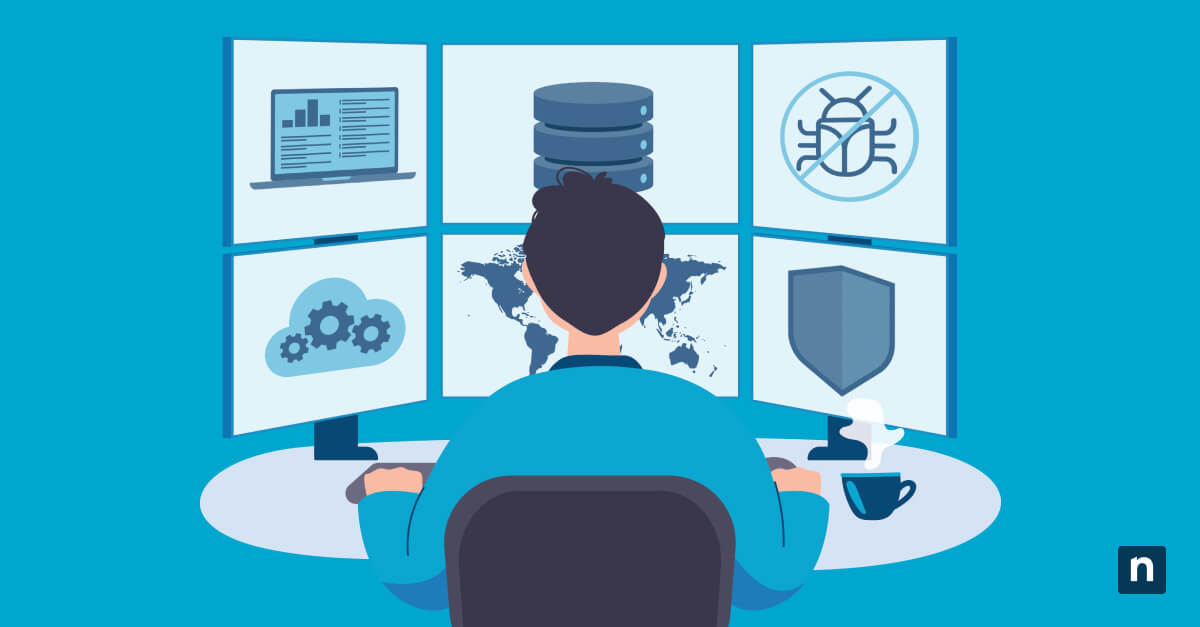Key points
- Server hardening reduces your attack surface: Server hardening is the process of minimizing vulnerabilities across your server infrastructure to protect against cyberattacks and unauthorized access.
- 9 key steps in server hardening: These include securing physical location, controlling access, configuring firewalls, managing server configurations, securing user accounts, patching vulnerabilities, removing unused software, backing up data, and continuous monitoring.
- Server hardening improves cybersecurity posture: Proper hardening protects sensitive data, prevents downtime, and helps organizations avoid costly breaches, reputation damage, and compliance failures.
- Challenges in server hardening: Misconfigurations, configuration drift, lack of expertise, and compliance complexity can all hinder effective implementation without the right tools and planning.
In any given IT environment, a server is the foundation that provides services for endpoints to carry out various actions. They are essential for computer networks to have shared access or information. Unfortunately, servers are often targets for cyberattacks due to their ability to reach other parts of the IT environment and wreak havoc. With these attacks rising, developing a server hardening process will help organizations improve their security posture.
What is Server Hardening?
Server hardening is a system hardening process that aims to protect and secure a server infrastructure against cyberattacks by reducing its attack surface. An attack surface consists of all possible points of a system where an unauthorized attacker can attempt to enter. Minimizing the number of these vulnerabilities “hardens” a server against exploitations and increases data security.
How Does a Server Hardening Process Work?
A server hardening process works by taking steps to guarantee that all aspects of a server are as secure as possible. With the help of tools like IT operations management software, you can gain better visibility of the different components in your server and ensure that each part of the process is properly executed. Each step in the server hardening process helps you to further secure and protect your server.
To see server‑hardening steps, you may watch this short video: ‘9 Essential Steps of a Server Hardening Process’.
Server Hardening Process: 9 Steps
A server hardening process contains many steps and actions. You don’t necessarily have to do them in a particular order, but each step should be completed to ensure your server is hardened and secure against cyberattacks.
1) Secure server location
Place your server in a safe location. Verify that the settings are ideal (temperature, proximity, etc.) and that the area is locked and restricted only to approved staff.
2) Control access permissions
Instituting the “principle of least privilege” effectively verifies that important systems, programs, configurations, and other operations are only accessible to those who need them. Limiting access to the business’s most critical business technology and operations creates an additional layer of security that makes a server compromise less likely.
3) Set up your firewall
A firewall is a barrier set in place to separate the computer network from any external sources, and it’s a security system for your computer network that monitors incoming and outgoing traffic. Setting up your firewall is a wise way to monitor traffic within your network and block unwanted traffic coming from outside the network, which can help prevent attackers from entering the network in the first place.
4) Manage configurations
There are multiple types of configurations to manage in your IT environment, such as user, server, network, and NTP (network time protocol). Active management of these different settings ensures consistency across all the systems in your IT environment. It also helps you gain visibility into systems across your server and know how they impact each other.
5) Secure user accounts
Protect the user accounts on your server. Keep usernames and passwords private, and make them strong and unique. Also, consider using MFA when possible to heighten the level of security.
6) Apply patches to vulnerabilities
Apply software patches as soon as possible and ensure your IT environment is continuously updated to ensure the highest security. Cybercriminals can easily exploit unpatched software on a server, so be sure to install updated software to protect those vulnerabilities. Read about the patch management process to learn more about effectively applying patches.
7) Remove unnecessary software
Keep your network tidy by removing software and applications you no longer use. It is difficult to identify hackers if they access your data through software you’re not actively using. Plus, an organized network is much easier to secure.
8) Plan a backup strategy
Back up your server data to ensure crucial organizational information is not lost in a cyberattack. Using designated backup software can help guarantee that your data is backed up correctly. Create a backup strategy that will best serve the needs of your organization.
9) Continuously monitor
Continually monitoring your server is a step that never ends in a server hardening process. Server monitoring allows you to be aware of any activity on your system, track log-ins, and know who’s accessing certain server areas. This knowledge will enable you to be proactive in securing your server.
The Importance of Server Hardening
It is vital to take preventative action and secure your organization’s server. If your server becomes compromised due to a hacker exploiting its vulnerabilities, you no longer have full control of the server. With the hacker’s newfound access, they could send spam mail, attack other servers, or install malware, all of which could result in corrupted devices or data, unplanned downtime, a damaged reputation, and extraordinary costs.
Server hardening is vital because it can mitigate the effects of possible cyberattacks, and it is key for securing the data and operations of your server. It is a necessary strategy that helps to support business uptime and continual operations.
The Challenges in Server Hardening
While it’s easy to follow the steps in server hardening, some may run into issues that will cause further bottlenecks. Here are some of the most common challenges in server hardening.
Security vs functionality
Disrupted services are possible when there’s an overkill in server hardening, impacting system functionality. For example, disabling a legacy protocol may block an older application that is still in use. With this in mind, organizations must balance security and functionality when hardening servers.
Lack of standardization across environments
Hybrid infrastructure often lacks homogeneous server hardening policies, leading to inconsistent enforcement and visibility difficulties.
Configuration changes
Continuous changes like updates, user changes, or new deployments may cause configurations to drift, leaving servers outdated. This is why consistent monitoring and automated patching are crucial to prevent vulnerability exposure.
Limited sources and expertise
A massive pushback for organizations is when they lack critical sources and workforce with expertise to perform server hardening. This can introduce risk and might cause system misconfigurations, delays in remediation, or reliance on default settings that leave servers exposed.
False sense of security
Server hardening is not a one-time task—it’s a continuous process done regularly. It also evolves over time to combat emerging threats and vulnerabilities.
Compliance complexity
Meeting regulatory requirements (e.g., HIPAA, PCI-DSS, ISO 27001) often requires specific hardening benchmarks. Navigating these frameworks while maintaining operational continuity can be complex.
Understanding these challenges is essential to planning and strategizing an effective, iterative, and sustainable server hardening process.
Utilize NinjaOne’s comprehensive resource for server hardening to secure your servers and endpoints more effectively.
→ Free Download: Endpoint Hardening Checklist
Increase Your Server Security Through Server Hardening
Cybersecurity is important for all businesses using technology in their day-to-day operations. Server hardening, in particular, is an essential process to keep your organization’s data and IT environment safe and fully functional. Check out server management to learn more tips and best practices on how to track and maintain optimal servers.
Through the use of remote monitoring and management software, NinjaOne enables simple and straightforward server hardening that allows you to view settings, configurations, and overall server health easily. Sign up for a free trial to see how NinjaOne can help you protect your server.








